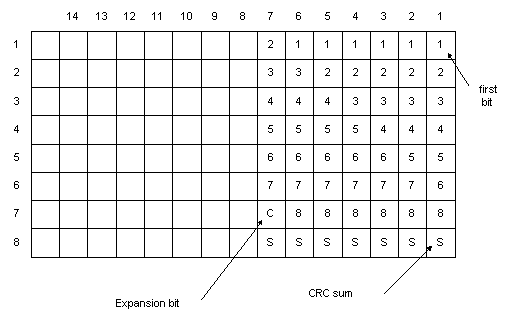
The GOLAY/GSC pager system originates in the USA and is based on the binary code found by Marcel GOLAY/GSC. GOLAY has been in use since 1973. The first standard defined only tone calling and could handle a maximum of 400,000 addresses. After 1982 the system also allows for alphanumeric transmission and up to 4 million addresses may be selected via a coded preamble.
|
Parameter |
Value |
|
Frequency range |
VHF |
|
Operation modes |
Broadcast FEC |
|
Modulation |
FSK |
|
Symbol rate |
300/600 Bd adaptive |
|
Receiver settings |
FM, BW = 15 kHz |
|
Input format(s) |
IF |
GOLAY Addressing Format

This illustration shows the basic address format of the Golay Sequential Code (GSC). It is constructed from two code words which are derived using the Golay (23,12) algorithm. The bit rate for each code word is 300 bit/s. Each received Golay word can contain up to three errors before integrity is compromised. The GSC is asynchronously decoded. To separate adjacent addresses, a separator word (comma) is transmitted at a rate of 600 bit/s.
The message format is based on eight BCH (15,7) code words that are grouped together to have exactly the same length as an address. Messages and addresses are thus easily interleaved. Each message block may contain up to 12 numeric or 8 alphanumeric characters. Messages which are longer than a single block may be transmitted using any desired sequence of blocks. By implementing block coding, two errors may be corrected in the BCH (15,7) codeword. The bits within a block are interleaved during transmission which allows the correction of burst errors affecting up to 16 bits, which is equivalent to a fading protection of 27 ms.
GOLAY Data Block with Eight Alphanumeric Characters

This illustration shows a block of eight alphanumeric characters of 6 bits each. The high fading protection is achieved by transmitting columns rather than rows (interleaving). In this way a burst error affecting 16 bits does not cause a character error. In addition each block contains a checksum computed by binary addition of the information bits of the other 7 words adding to the error detection capability of the system.
In high capacity systems the GSC makes use of grouping. For this purpose 16 calls are stacked together. Each stack is preceded by one of 10 copy information blocks that consists of 18 repetitions of a single Golay codeword. In this way all receivers in a system are grouped in 10 header block groups and each receiver only has to decode the stack that is preceded by its particular header block.
GOLAY also has a facility for optimizing voice calls. A special audio control code is used to separate voice messages.
GOLAY uses direct frequency modulation. Proper decoding is only possible from the receiver IF output (455 kHz, 10 MHz or 21 MHz).